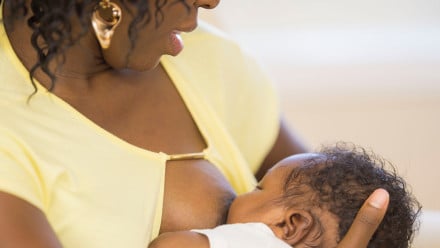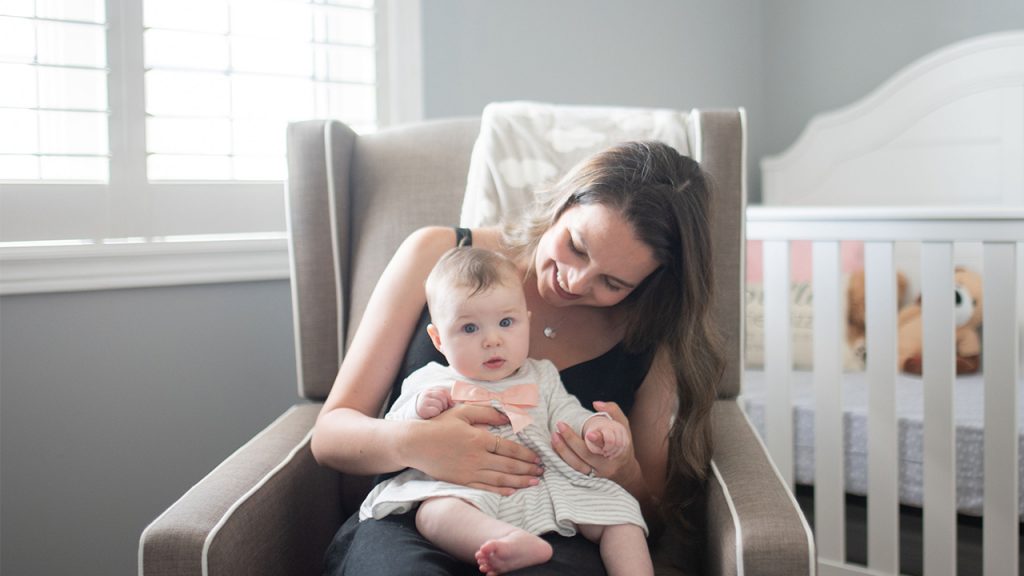I almost gave up breastfeeding before discovering a nipple shield
[ad_1]

The author with her daughter. Photo: Sounds Like Yellow Photography
I was sitting on the floor of the nursery at 2 a.m., trying to hold my three-day-old baby girl gently rather than in a vice grip that would betray the excruciating pain I was in trying to breastfeed her. No matter how many beautiful platitudes my husband desperately whispered in my ear, the only words I was hearing were, “If you’re doing it right, it won’t hurt.”
My water had broken ten days after my due date on a night so cold the hospital’s parking gates froze shut. Almost 48 hours to the minute later, my daughter entered into the world. I had become maternity ward lore with my lengthy labour; nurses popped in and out of our room to check my dilation and exclaim, “We can’t believe you guys are still here!” The birth itself was a relatively easy two-and- a-half-hours of pushing, thanks to an epidural, an incredible support staff, and a carefully curated Beyoncé playlist.
I didn’t cry when they put her on my chest, either from sheer exhaustion or perhaps the knowledge that the hard work had only just begun. And first on the list of hurdles to jump: breastfeeding.
Throughout my pregnancy, I tried to stay realistic about nursing, reading numerous articles and essays about women for whom it just didn’t work out. I desperately wanted to do it, but hoped that, if it wasn’t in the cards for me, I could save myself the heartache by printing out enough research to reassure myself that I wasn’t to blame.
After the birth, a nurse led me through my first feed. It took a few tries, but eventually I was told that everything looked great. Still, I continued to have doubts about my baby’s latch, because it had been relentlessly drilled into my head at our prenatal classes that if I were doing it right, breastfeeding wouldn’t hurt. It wasn’t hurting at this point, but it was definitely uncomfortable. In place of what I had assumed would be a feeling of gentle sucking was a dull sort of burning, like when you get into a bath that’s a touch too hot.
No fewer than three nurses sent me home with a thumbs-up on my feeding technique and the promise that it would become seamless in no time. Less than two days later I was on the floor of my baby’s room trying not to scare her with my cries of pain. In less than 24 hours, my nipples had both cracked badly, thanks to a baby who was cluster feeding on an hourly schedule—leaving my breasts with no time to catch a break in between.
 How to deal with breastfeeding painAs I desperately searched online for some kind of lifeline, I couldn’t stand to let a nursing session last very long. The pain, now a toe-curling white-hot sting, was immediate. And instead of easing up slowly like my mom friends had promised, it only continued to intensify, to the point where I would have to pull my baby off and take a break with a cool compress. The only remedies I found involved warm showers (which I couldn’t handle without wearing a bikini top) or lanolin cream (which didn’t get a chance to heal anything because I was breastfeeding so often).
How to deal with breastfeeding painAs I desperately searched online for some kind of lifeline, I couldn’t stand to let a nursing session last very long. The pain, now a toe-curling white-hot sting, was immediate. And instead of easing up slowly like my mom friends had promised, it only continued to intensify, to the point where I would have to pull my baby off and take a break with a cool compress. The only remedies I found involved warm showers (which I couldn’t handle without wearing a bikini top) or lanolin cream (which didn’t get a chance to heal anything because I was breastfeeding so often).
My breaking point came after a particularly bad feed when I pulled my daughter away from my breast and saw blood around her mouth. After three days of no sleep and a body that hurt from the inside out, I handed her off to my husband and lay on the floor to cry. In two hours of trying, my baby had only eaten for maybe a total of 15 minutes.
Before I was discharged, the hospital had booked me in for an appointment at their breastfeeding clinic two days later. It was highly recommended that I attend in case I had any lingering questions about the latch or worries about my baby’s weight gain. I decided that if the only help they could offer was to tell me to “tough it out”, I would tell the nurse that I refused to go through this pain anymore and would be switching to formula. I began to count the hours until my breasts could actually begin to heal.
But things didn’t go as expected. Going in, I was in a funk; no matter how many things I had read, I couldn’t help feeling like a failure for giving up so quickly. Walking out, I was crying tears of happiness and couldn’t believe that I had just fed my daughter for 45 minutes straight.

My answer came in the form of a nipple shield, a thin silicone cover placed over my nipple that provided a bit of a barrier during a feed. It seemed so simple, but it had taken countless hours of scrolling through Google before I stumbled on a website that mentioned it as a way to save sore nipples. I had landed on it during the car ride to my appointment and brought it up with the nurse leading the class when she recommended yet another tube of lanolin cream. Although she hadn’t seemed reluctant to sell one to me, she also didn’t offer one to anyone else in the class who complained of cracked or sore nipples.
No nurse, lactation consultant or prenatal class had ever mentioned that there were tools that could help with the initial pain of breastfeeding; I had to be the one to ask for it at the clinic. And despite my proclamations about how it changed my experience completely, the next breastfeeding class I attended at the hospital was spent with a new nurse calling the shield a “crutch” and trying to dissuade me from using it. She wouldn’t drop the subject until I flat out said I’d probably turn to formula if I ditched the shield. When it was time to leave, she once again reiterated that the shield would only harm my breastfeeding in the long run. I stopped going to the classes at the hospital.
When it became clear that none of my friends had even heard of nipple shields, I had to wonder why they were so taboo. My favourite new-mom bible, What To Expect the First Year, only mentioned shields in passing and just to ensure they weren’t purchased in place of breast shells, which help correct inverted nipples and ease engorgement, but aren’t worn while nursing. All my research seemed to suggest that experts routinely discourage new moms from using the shields (unless they have inverted nipples) because, if used improperly, there’s a risk that baby won’t get enough milk and that mom’s milk supply will decrease as a result. There is also the chance of an increased risk of blocked ducts and mastitis.
I found another clinic and went in ready to apologize for using the shield and offer up mostly empty promises that I would try to wean my baby off soon. But instead of telling me that I’d have to go back to suffering through breastfeeding, this new nurse and lactation consultant told me exactly what I needed to hear: “As long as baby is gaining and growing and you’re comfortable with using the shield, use it for as long as needed.” (And yet, she declined to be named for this story, showing just how controversial the shields really are.)
While this godsend of a nurse did advise a few techniques for eventually weaning baby off, she mentioned another client of hers who successfully used the shield for two years. Once again, I left a clinic walking on air, finally comfortable with how I was nourishing my baby.
My daughter is now 8 months old and we’re still using the shield for feeds. I’ll admit that nursing this way isn’t perfectly ideal. I can’t leave the house without double and triple checking that it’s in the diaper bag, and it makes feeding a little awkward in public.
But that doesn’t come close to overshadowing the fact that she’s happy, healthy and hasn’t felt her mother’s hot tears on her face since she was a week old.
Read more:
7 surprising reasons breastfeeding is good for babies
Here’s exactly how your body makes milk (spoiler: it’s freakin’ amazing!)
[ad_2]
Source link



